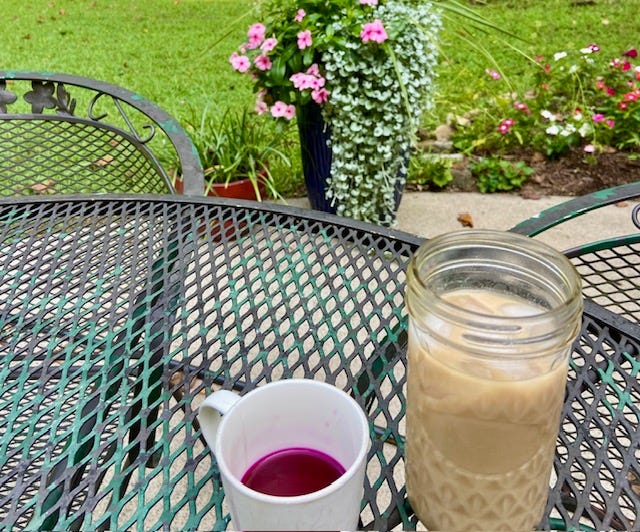
Though I would never discourage anyone from experimenting in the kitchen, this edition of Food Majors is not targeted for the beginner on their food journey. I recognize that beet kvass is certainly out of the ordinary for the average American diet. Actually, 15 years ago it was one of the first fermentations I tried from Nourishing Traditions.
What is Beet Kvass?
It’s a salty tonic made with beets.
ton·ic
/ˈtänik/
noun a medicinal substance taken to give a feeling of vigor or well-being.
Benefits of Drinking
Digestion: The fermentation process can help with digestion.
Liver cleansing: Beets can help cleanse the liver.
Blood pressure: Beets can help lower blood pressure.
Brain stimulation: Beets can help stimulate blood flow to the brain.
Probiotics: Beet kvass is a good source of probiotics, supporting a healthy gut.
Hydration: Beet kvass can be hydrating.
Sugar cravings: Beet kvass can help reduce sugar cravings.
Yeast and fungus: Beet kvass can help with yeast and fungus in the body.
May help reduce the risk of cancer due to its antioxidant and anti-inflammatory properties.
Contains B vitamins that support the immune and neurological systems, as well as betaine, which can help reduce inflammation.
Particularly I’m interested in kvass bc of the liver detoxing properties. I took a strong anti-fungal prescription for nail fungus in high school and am always concerned about my liver. The doctor periodically tested my blood when on this expensive (and probably experimental!) medication. The mention of blood testing should have been my first sign it was toxic!
I’ve made beet kvass a handful of times over the years, always wondering if I was doing it right. I made some the day I got home from The School of Lunch Training Academy (SŌLTA) in California because we tasted some there.
At SŌLTA I asked questions of a gal with a Russian accent about how she made beet kvass. She grew up drinking kvass made traditionally from rye bread.
How to Make Beet Kvass
This was her method:
In a half-gallon jar
3 beets the size of tennis balls (mine were smaller) cut in quarters
1.5T Redmond Real salt or any non-iodized salt
2 cloves garlic (I also added a jalapeño)
fill with filtered water
Shake daily for 3-5 days. Allow to ferment 3 weeks then strain and refrigerate. She uses an airlock but I did not.
She’s in Texas and estimated her kitchen temp is close to 80*. She sometimes does another batch reusing the same beets. Her family prefers chioggia beets, which look like a bulls eye when sliced through equator (pictured first, above). These are sweeter beets. I’ve used them before for kvass and don’t prefer the sweeter taste. She said kids prefer the sweeter beets.
In previous batches I’ve only fermented beet kvass for 3-4 days before removing beets and refrigerating.
This time I left it on the counter for 9-10 days.
My kitchen is probably 74-75*.
Reminder: fermentation is a function of three things - time, temperature, available salt/sugar. When the kitchen is warmer things ferment faster. When there is a larger source of sugar, it takes longer to fully ferment. Salt helps slow fermentation.
I was fearful in the beginning I had not used enough beets (source of sugar) because the water was a lighter pink and rather clear but each day it seemed to become more opaque.
By day 3 I saw bubbles. These bubbles are a sign of fermentation! I used a glass weight to keep the jalapeño slices submerged and when I moved the jar bubbles rose from underneath the weight.
Each day I removed about 2 tablespoons to drink starting about day 3. I like to taste my ferments as they age and take note of subtle taste differences.
On the night of day 8 I noticed a distinct shift in flavor. And day 9 or 10 the salt was significantly reduced. So much that I decided to remove the veggies and refrigerate. My original intent was to let it ferment for three weeks as my Russian friend does.
My fear was there wasn’t enough salt to inhibit growth of bad bacteria. However fermentation guru Sandor Katz says fermentation is possible without salt — it’s just trickier.
I refrigerated early mostly because I noticed a slight film on the surface. It wasn’t kahm yeast, which is common in ferments. Kahm isn’t harmful. Mostly unsightly and sometimes has an off flavor. The film on the surface was almost oily in appearance and ever so slight. I wonder if it was from dipping a spoon in it every day.
Kvass has seemed elusive to me over the years. I buy it on occasion because I’m ever so curious about what it “should” taste like. It always tastes like salty beet water. This batch now in my fridge isn’t salty and I wonder about it… I wish there was a way to test the diversity and abundance of probiotics in home kitchens.
It hasn’t killed me so must be making me stronger!
Would love to hear any thoughts/feedback if you’re a kvass drinker.
Life is hard; food doesn’t have to be.
Julie



